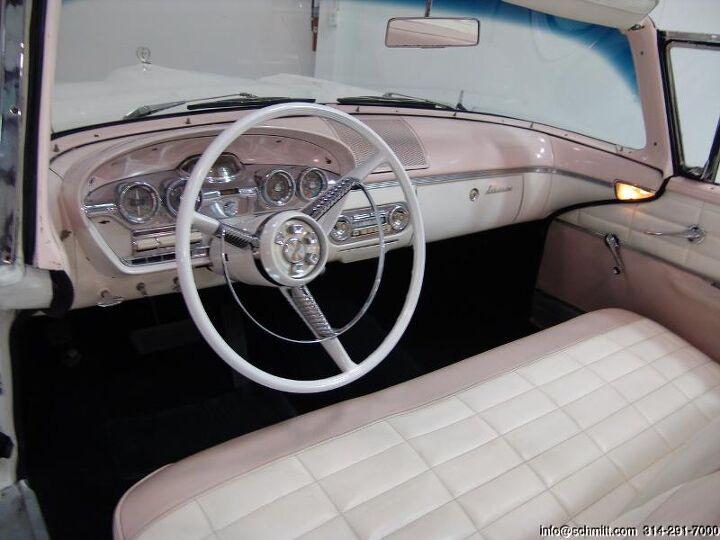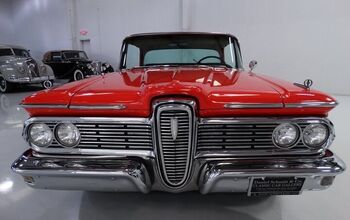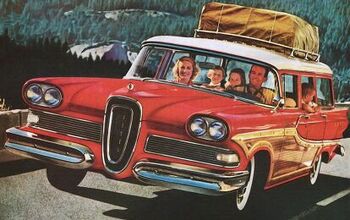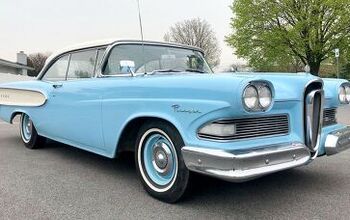Abandoned History: The Life and Times of Edsel, a Ford Alternative by Ford (Part IV)

In our last edition of Abandoned History, we found ourselves in the earliest days of Edsel sales in 1958. The new company offered a full lineup of four sedan-based models and three different wagons. But because Edsel failed so spectacularly, 1958 was the only year it had a broad product offering. Four of seven models were eliminated before the company’s second model year.
Last time we covered the cheapest of the one-offs, the Pacer. Its near entry-level status confused customers as it wasn’t exactly a cheap vehicle at $2,700 ($27,973 adj.) before options like a heater or radio. Pacer was also based on a Ford, but priced more like a Mercury. Still, the Pacer found 19,057 customers in its only year; many more than the upmarket Citation found during its outing.
In 1958, the Citation was the most expensive sedan offered by Edsel. With its flagship status, it was considerably more expensive than the priciest Ford full-size (Fairlane 500) but was approximately on par with the Mercury Montclair. The Montclair resided in the middle of a Mercury lineup that was reworked for 1958, following the unsuccessful rework of 1957.
The conclusion of 1956 saw two lower-level Mercury models, the Medalist and Custom, meet their ends. Monterey continued as the entry-level full-size, with Montclair in the middle and the much more expensive (and incredibly garish) Turnpike Cruiser as the flagship. 1957 also saw the division of Mercury’s wagons into their own nameplates, as Commuter, Voyager, and Colony Park arrived. Mercury’s sole other offering was the M Series pickup.
The lineup was adjusted again in 1958 as a new flagship Mercury - Park Lane - arrived as a more suitable luxury product. That meant the Turnpike Cruiser was demoted to a version of the Montclair. Sold alongside the Turnpike Cruiser for a single year, Park Lane expressed its flagship status through its much larger size.
The Monterey and Montclair rode on the same 122-inch wheelbase and were mostly differentiated by their equipment levels. The Montclair was even the exact same length as the Monterey, at 211 inches. It was from this basis that Edsel created the more expensive Citation. To stand out as a new and unique model, it had different dimensions in every direction compared to the Monterey and Montclair.
Edsel’s engineers stretched the wheelbase of the Montclair by two inches (to 124”) to create the company’s largest sedan. The Citation was also notably longer than the Montclair at 218.9 inches, nearly an eight-inch difference. Overall width increased for the Citation, to 79.8 inches versus 79.1 on the Mercury. With its brand-mandated trim, equipment, and styling, the Citation also weighed between 400 and 500 pounds more than the Mercury upon which it was based: Citations tipped the scales at 4,300 to 4,500 pounds.
Part of that weight was in the V8 engine, as the Edsel had exclusive power not offered on the Montclair. Montclair’s power was confined to 312 and 368 cubic inch V8s, while Citation was equipped as standard with the 410 (6.7-liter) MEL V8. As mentioned previously, the MEL stood for Mercury-Edsel-Lincoln and was a line of new V8s meant only for Ford’s more expensive cars. In Citation usage, the 6.7 had a four-barrel carb and produced 345 horsepower and 475 lb-ft of torque.
MEL engines arrived in 1958 as a replacement for Lincoln’s Y-block V8, in production from 1952 to 1963. And though Lincoln engineers designed the Y-block, the company didn’t much care for it: The last time a Y engine saw Lincoln usage was in 1957. All Citations used the three-speed Cruise-O-Matic automatic, specifically the MX version that was intended for heavier-duty usage. Teletouch transmission controls in the wheel were standard on all Citations.
Befitting its upscale status Citation offered a limited selection of body styles, and notably absent was a pillared sedan. Citation was sold with two doors as a hardtop coupe and convertible, and with four doors as a pillarless hardtop sedan. As it was based on a Mercury instead of a Ford (as in the Fairlane-Pacer relationship), styling changes for the Citation were slightly less jarring.
It must be said the Montclair for 1958 was not the most beautiful car ever made, especially in Turnpike Cruiser trim. To that starting point, Edsel added its vertical horse collar grille, just like it had on the Pacer. The bumper of the Montclair was supposed to look like a two-piece design in 1958, so Edsel’s designers just went all the way and physically separated the chrome.
The front bumper’s overall design was simpler on the Citation, as the Montclair had a grille insert on both sides. Citation’s grille was above the bumper and consisted of horizontal chrome slats on either side. Turn indicators were integrated within the grille in a wrap-around style. The headlamps lost their metal awnings in the transition into Edseldom and protruded from their cylindrical exits on either fender.
While the Montclair used a rounded character line at the fender, Edsel opted for a much stronger spear-shaped protrusion. The sharp edge held firm all the way to the rear tail fin. Underneath, Citation badging at the front of the fender drew the eye to a trim spear that angled downward after the door. That trim led into the rear’s scalloped side detail that was always painted a contrasting color. For the Citation, the insert in the side panel was made of aluminum and anodized in gold.
The roof and glass area were generally the same on the Montclair and the Citation, but the cars avoided looking similar from the side because of their rear wing detail: Montclair had its rear scallop placed high on the fender and wore a full-length trim strip along its side. In Turnpike Cruiser trim the two cars were more distinct from one another, as the Mercury used a Breezeway window not found on the Edsel.
At the rear, the Citation adopted the company’s horizontal fin orientation and a rear clip that was more aggressive than the Montclair. Montclair maintained a rocket-inspired design on its rear lamps, decorated with chrome rings. Below, a separate pair of lamps were encased in the big chrome hoops of the bumper. The lamps had four segments on either side and looked heavy-handed and fairly bad. The Edsel was a model of restraint in comparison, with a one-piece bumper of a much simpler design, and only two total rear lamps.
With much standard equipment, Edsel asked a pretty penny for its Citation. Its starting price of $3,500 ($36,257 adj.) ranged to $3,766 ($39,013 adj.) fully loaded. Again it was a mixed bag of competition with Mercury, where the standard Montclair asked between $3,236 ($33,522 adj.) and $3,597 ($37,262 adj.), and its sub-model Turnpike Cruisers asked $3,498 ($36,236 adj.) and $3,577 ($37,055 adj.).
Customers could not justify the price jump over its Mercury siblings, particularly when Edsel failed to appeal from a styling perspective and the standard Teletouch was annoying to operate. Just 8,577 Citations were sold in 1958, or 13.5 percent of total company sales that year. The most popular Citation was the sedan, which sold 5,112 copies. The hardtop managed about half that at 2,535 sales. Almost nobody wanted a Citation convertible, and only 930 sold.
Like the Pacer, the Citation was canceled after its initial poor showing. We’re exactly halfway through the one-offs in the Edsel collection, and next time we’ll move on to the wagon class of 1958. Does anyone care for a Roundup?
[Images: Ford, Dealer]
Become a TTAC insider. Get the latest news, features, TTAC takes, and everything else that gets to the truth about cars first by subscribing to our newsletter.

Interested in lots of cars and their various historical contexts. Started writing articles for TTAC in late 2016, when my first posts were QOTDs. From there I started a few new series like Rare Rides, Buy/Drive/Burn, Abandoned History, and most recently Rare Rides Icons. Operating from a home base in Cincinnati, Ohio, a relative auto journalist dead zone. Many of my articles are prompted by something I'll see on social media that sparks my interest and causes me to research. Finding articles and information from the early days of the internet and beyond that covers the little details lost to time: trim packages, color and wheel choices, interior fabrics. Beyond those, I'm fascinated by automotive industry experiments, both failures and successes. Lately I've taken an interest in AI, and generating "what if" type images for car models long dead. Reincarnating a modern Toyota Paseo, Lincoln Mark IX, or Isuzu Trooper through a text prompt is fun. Fun to post them on Twitter too, and watch people overreact. To that end, the social media I use most is Twitter, @CoreyLewis86. I also contribute pieces for Forbes Wheels and Forbes Home.
More by Corey Lewis
Latest Car Reviews
Read moreLatest Product Reviews
Read moreRecent Comments
- Lou_BC Well, I'd be impressed if this was in a ZR2. LOL
- Lou_BC This is my shocked face 😲 Hope formatting doesn't fook this up LOL
- Lou_BC Junior? Would that be a Beta Romeo?
- Lou_BC Gotta fix that formatting problem. What a pile of bullsh!t. Are longer posts costing TTAC money? FOOK
- Lou_BC 1.Honda: 6,334,825 vehicles potentially affected2.Ford: 6,152,6143.Kia America: 3,110,4474.Chrysler: 2,732,3985.General Motors: 2,021,0336.Nissan North America: 1,804,4437.Mercedes-Benz USA: 478,1738.Volkswagen Group of America: 453,7639.BMW of North America: 340,24910.Daimler Trucks North America: 261,959










































Comments
Join the conversation
Very nice article and photos. I am a HUGE Edsel fan. I have always been fascinated with the "Charlie Brown of Cars." Allow me to make a minor correction to add here: the Pacer line was the second-from-bottom rung Edsel, not the entry-level trim. That would be the Edsel Ranger for 1958. It had the widest array of body styles. The Ranger 2-door sedan (with a "B-pillar", not a pillarless hardtop), was priced at $2,484. So, the Ranger and Pacer both used the smaller Ford body. The next two upscale Edsel's were based on the Mercury body, are were: Corsair, and, top-line Citation. Although the 1959 style is my fav. I would love a '58 Edsel Pacer 4-door hardtop sedan!
To: article author: My Pleasure! I just don't want to be seen as a "know-it-all". There is a good detailed article on Wikipedia about the poor Edsel. Many believe that Ford gave up on it too soon, although there are a variety of reasons why Edsel was not popular. It actually sold respectable well, considering that this NEW nameplate was introduced during a Recession.